Steven Sinofsky worked at Microsoft from 1989-2012 and oversaw the Office (1998-2006) and Windows (2006-2012) teams. In this excerpt from his draft book, Hardcore Software: Inside the Rise and Fall of the PC Revolution, he writes about three Office viruses, WM/Concept.A, Melissa, and ILOVEYOU. Along with besieging PC users, they led the company to reassess some of its fundamental philosophies about its products. ILOVEYOU—the last, most infamous, and pernicious of these attacks—first hit inboxes on May 5, 2000, 20 years ago today.
Microsoft was not always an enterprise company. In fact, for the first 10 years of my time at the company, starting in 1989, Microsoft was decidedly and almost entirely dependent on retail sales—selling one copy of Office or Windows (with a new PC) at a time at stores now long forgotten, such as CompUSA, Egghead Software, or Computer City. After the release of Office 97 (the product that introduced Clippy, that helpful assistant that was criticized at the time, but was in fact well ahead of its time), the Office team, which by then I was leading, began the transition to building a product more suited to the enterprise. That meant doing features business users required, not just snappy personal productivity features that demonstrated well. In fact, we often felt doing what was good for enterprise was the opposite of doing what was good for individual end users.
With Office 2000, we found we had tilted too far to the enterprise side. The product proved to be incredibly stable, and was easier to use than ever. But it lacked anything interesting to grab the attention of customers. We learned that listening too closely to customers wasn’t always the best approach—customers tell you what they want, but that’s no promise they will buy when the time comes.
We needed to find a way to appeal to both individuals seeking a better product and enterprises seeking a more suitable product for their needs. We needed to walk and chew gum at the same time, so to speak. Just as we were getting our brains wrapped around the idea of navigating these conflicting customer needs, we had to work our way through an emerging global software crisis that revealed itself in three decidedly enterprise ways, all of which became ours alone to solve. We were, after all, the leader in desktop software in the enterprise.
The dawn of Y2K was upon us, and customers demanded a robust effort from Microsoft, which we would deliver. At the same time, our products were increasingly viewed as buggy or unstable. Something needed to be done about that—it was the price of success. Closely related to ever-present bugs was the increasing prevalence of computer viruses. While viruses were not new, the massive penetration of Microsoft’s new email solution (Exchange and Outlook), the internet, and global connectivity created fertile grounds for a new generation of viral attacks on computing.
This is a story of a global attack on the new Windows PC infrastructure that brought the world’s PCs to a halt, literally causing billions in damages overnight, and how the team came together in crisis to come up with a solution. The details are unique to the era and computing at the time, but the lessons learned are universal in the time of crisis.
ILOVEYOU breaks out
One morning during the first week of May of the new millennium, I received a call at my apartment while I was getting ready for work. I heard a female reporter tell me her name, and then basically listened to her hyperventilating and proclaiming her love for me repeatedly: “I love you. I love you.”
That’s what I heard, anyway. The call. A reporter. Early morning. It was all weird.
In reality, LOVE broke out all over the internet. Over the span of a weekend, inboxes around the world of Outlook and Exchange email users were inundated with dozens of copies of email messages with the subject line, “ILOVEYOU.”
I learned from the reporter that the LOVE email incident was deemed so serious that the PR lead gave her my home number and simultaneously sent me a briefing via email. In the era of dial-up, I could not read the email and talk on the phone because I only had one analog phone line at home. I had no idea what was going on, so I agreed to return the call after I dialed up and downloaded my email.
That’s when I realized the magnitude of the issue.
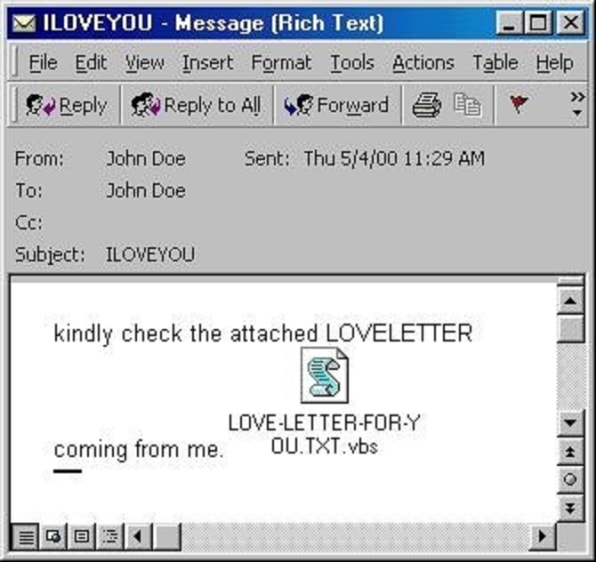
For all the positives of the PC in business, IT professionals still wrestled with the freedom of PCs, not only the freedom to create presentations and spreadsheets but the freedom to potentially wreak havoc on networks of connected PCs because of computer viruses. Viruses were hardly new, part of PCs from the earliest days. As a new hire in the Apps Development College training, I completed a unit on early MS-DOS viruses. The combination of many more PCs in the workplace, networking, and then email created a new opportunity for those wishing to do harm with viruses. By their nature, and by analogy to the word “virus,” most viruses are not fatal to a PC. But they can cause significant damage and loss of time, and take a good deal of effort to clean up.
Enterprise IT was increasingly uneasy about viruses and had the expectation that Microsoft must do something about them. The openness of the PC platform was a hallmark feature responsible for the utility and breadth of the PC ecosystem, even if some bad actors (as they were called) might exploit that openness. Microsoft took a laissez-faire approach to this annoyance.
Office shared this attitude until the mid-1990s and the rise of networks, when sharing files became common. With everyone connected, an annoyance morphed into a virus that shared itself automatically between computers. A virus infected Microsoft Word 6.0, called WM/Concept.A (viruses often had cryptic names). In this case the WM stood for Word Macro, and presumably Concept referred to the fact that this was testing a new concept for viruses.
Contrary to what was commonly believed, successful viruses didn’t usually do anything harmful.
This was a new type of virus. It did not exploit bugs or programming mistakes in Word. Concept used Word macros as they were designed. Macros were present in software for ages, going as far back as the MS-DOS days of WordPerfect and Lotus 1-2-3. Called “programmability” or “extensibility” in Microsoft lingo, they were a prized accomplishment and something BillG (at Microsoft we always referred to people by their email alias) believed in pushing for all products.
Programmability made a product sticky when customers invested time and effort to write macros. Macros were used to automate repetitive tasks: For example, if a company wrote similar letters to customers for past due notices, one could write a macro, which generated letters with all the right address fields and salutations. Another example might be to automate collecting sources in a document and creating a bibliography. The uses for macros were endless, and an entire industry developed for consulting and training in Word automation.
Word macros used a derivative of the BASIC programming language. Some were written to automatically run as soon as a file was opened, making systems appear more automatic to end users. The WM/Concept.A virus took advantage of this combination of features to create an exceedingly simple and yet maximally annoying experience: macros, automatic start-up, and networked file sharing.
The original author of WM/Concept.A probably crafted a tantalizing document with the virus and shared it on a network, knowing others would open it. Once they did, every document they created or opened became infected. Any document they shared became infected and infected every PC that opened that document. Like the old shampoo commercial, ” . . . and they told two friends, and they told two friends, and so on, and so on.” Well, that is exactly what happened. WM/Concept.A circled the globe relentlessly.
Contrary to what was commonly believed, successful viruses didn’t usually do anything harmful like delete all your files or format your hard drive. If they did, the viruses failed to spread and serve their purpose. WM/Concept.A did only one annoying thing other than propagate, and that was to display a message that looked like a broken Word error message—a simple window with the character “1” and button labeled “OK.” That was it. The message showed up once during the initial infection.
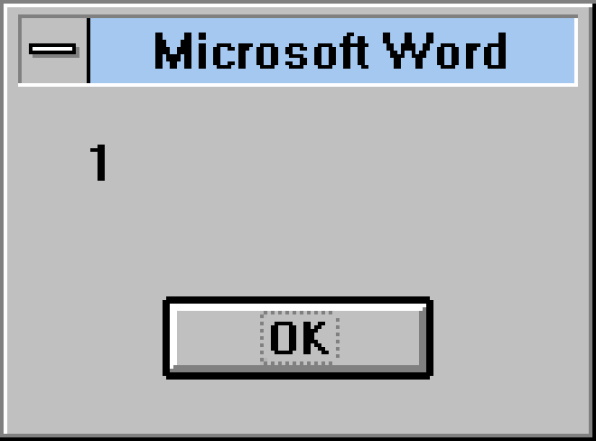
While there was no direct harm to PCs or any documents, the obvious implications of this Concept were that viruses could easily spread and, if the author wished, could do significant harm or at the very least truly interrupt workflow. They could do heinous things such as delete text at random times or worse. Removing WM/Concept.A from an infected system was a chore. A cottage industry of virus removal and disinfecting was born, as was a cottage industry of using Concept techniques to do more harm.
The response—and pushback
With this virus, the general manager of Word, Peter Pathe (ppathe, but he also maintained the alias “Blue” from his college days both online and in real life), decided to take the first steps on Microsoft’s antivirus crusade. Blue and the team changed the way macros worked. They added a warning noting that a document contained a macro, and also made it more difficult to run macros automatically when simply opening documents. These were small steps. But in spite of the awfulness of WM/Concept.A, they were greeted with much pushback by Word fans and IT managers, because the changes broke business systems and workflows. Blue stood his ground, and Microsoft’s Product Support Services (PSS) team proactively worked with customers to get the word out, so to speak.
WM/Concept.A was our first lesson in the incredible balance between building an extensible and customizable system and the need to maintain security and reliability on PCs, and how customers push back when making products more secure means making changes in how they work. But the virus scared me in a much broader way. I wrote a frantic 20-page memo, “Unsafe at Any Megahertz.” The title was a reference to the Ralph Nader book that shook up the auto industry in the 60s. It was meant to be a call to action for our product engineering.
The software industry had grown up from the counterculture 1960s. Steve Jobs with no shoes. Bill Gates hacking his high school computer system. Both college dropouts. What the PC industry lacked was any formal notion of what it meant to be a software engineer. My clarion call was that our lack of formalism, reproducibility, and external validation would only result in heavy-handed government regulation. I pondered a sort of Underwriters Laboratory for software. That would be scary. I never sent the memo for fear it would be viewed as just too controversial in a company and industry that was the epitome of informal. Instead, the memo was a good exercise for me in writing is thinking, and it made me double down on how Office would operate with respect to product quality.
The ability for bad actors or even pranksters to wreak havoc on the growing and newly connected PC infrastructure became a major liability for Microsoft. Yet our products were behaving exactly as designed, and customers appreciated those design patterns—extensibility was a major selling point of Office and a major part of our product and engineering efforts. As soon as we introduced the functionality changes, new viruses were created that circumvented what protections were in place.
While we were in the midst of creating the vision for Office10—the product that would become Office XP—in early 1999, our PR firm, Waggener Edstrom (often called WaggEd), received an inbound request from John Markoff of The New York Times. Markoff was one of the most respected reporters in technology, with a deep history in reporting on all aspects of the industry, especially on intensely technical topics. He received broad acclaim for two books on hacker culture and in particular the effort that led to the identification and capture of Kevin Mitnick, who was convicted of several computer-related crimes.
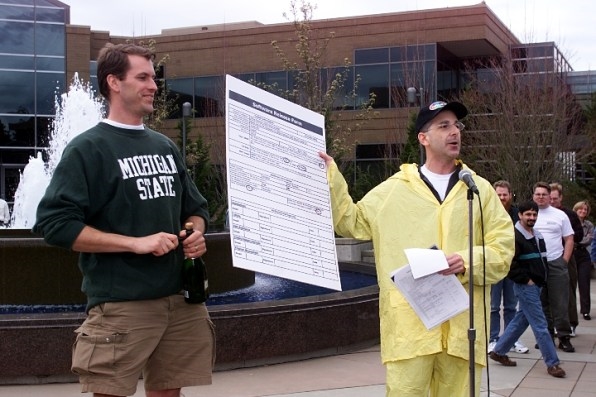
In our case, Markoff inquired about a feature in Office 97 and Office 2000, and a related feature in Windows 98. He was asking following a tip he received, which we later learned was from a programmer, well known to Microsoft, who built tools for MS-DOS. Markoff was told that documents created with those versions of Office seemed to have been stamped with what the tipster referred to as a “digital fingerprint.” Related to this, it appeared as though the programmer discovered that Windows 98 was also creating what amounted to a fingerprint for an entire PC using similar technology. The combination meant both documents and PCs seemed to have fingerprints.
Kim Bouic (now Barsi) of Waggener Edstrom called me right away. Kim was the PR executive leading the Office business and was exceptional at handling crisis situations like this. On the one hand, she talked me down from lecturing reporters about how they didn’t understand, and on the other gently reminded reporters that things might be more complex than they seemed. Her skills were needed more than ever as “digital fingerprint” was rapidly becoming a crisis.
Markoff was chasing two lines of inquiry, and they were leading to the same conclusion, which was that Microsoft created some sort of fingerprint or serial number in Windows and Office. If so, this constituted a major risk to privacy, because documents and computers could be traced using this technology. As if this weren’t enough, Intel announced the new Pentium III chip, and it contained a unique serial number which Intel said was for security use, but fed right into the narrative of serial numbers for tracking PCs. To make this all the more ominous, in one of the early discussions with Markoff on Windows, someone referred to the technology as a GUID (pronounced goo-id), an acronym for globally unique identifier.
Big Brother was suddenly part of the story.
GUID was the name of the Windows functionality that did, in fact, create what was intended to be a unique number—something useful for a broad range of programming tasks. The origins of Microsoft GUIDs were buried deep within the system, but the value of a number that was for all practical purposes unique beat people trying to create a number on their own, something that eluded computer scientists for years—in fact, the origins of GUIDs went back at least to early 1980s Open Software Foundation work and were originally called UUIDs, for universally unique identifiers.
To create the unique number, the GUID creation function combined several pieces of information. One of them was the serial number of a network card called the MAC address, which was relatively unique and required for networking. That serial number remained visible in the GUID. So someone with a GUID and access somehow to serial numbers of network cards could identify a computer. The fact that there was no database of MAC addresses or even anyone keeping track of them, or that MAC addresses were part of the lowest level of how the internet worked, were all facts lost in the moment. Much to Kim’s frustration, I continued to try to explain.
Pro tip: If in a PR crisis you find yourself explaining some deeply technical thing, stop. I could not stop. Kim was annoyed.
The specifics of how Microsoft ended up using GUID technology made this look bad, and that was what Markoff was onto.
This conspiracy theory ran deep.
In Office 97, we introduced hyperlinks as a native feature inside documents. It was part of our push to make Office great for the web. From within any Office document, clicking a link opened the browser. We were especially interested in links between Office documents on a web server. One problem with Office documents is that if files are renamed or moved then the link breaks. The WWW was already well known for broken links. In the corporate world, with reorgs and project name changes, files moved around a lot.
We decided that by using the FrontPage website management software on the server, we could keep track of links used in Office documents and detect when a file was moved, and then repair the links. We thought this was a great way to prevent what was becoming a huge web problem of broken links. We needed something more than a file name, since multiple files in a company might frequently have the same name. A clever idea was to use the new GUID feature of Windows to create GUIDs, and when a link was created to a document a GUID was also recorded. Links in HTML used the file and folder name, so if the file was moved or renamed, the link broke. Having a GUID also gave us a chance to fix the link and find the file using the FrontPage server. We thought this was a useful and solid plan.
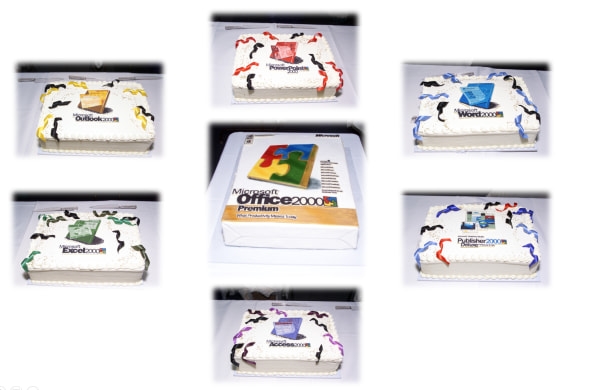
Will Kennedy (WillK) was the development manager on the feature in Office 97, though he moved to Outlook shortly after we began Office10. An Alabama native, college hire, standing 6 foot, 5 inches tall, Will was the epitome of a calm development manager. I forwarded him some of the mail from Markoff describing the feature. He walked through all the Office code with the test team and ascertained we did store the GUID in a document (to further the conspiracy, the GUID was not visible to end users in any way and was hidden in the file). However, as Office 97 progressed, albeit late, we never implemented the fix-up feature, but the GUIDs remained. That seemed benign at the time. Will said it was trivial to remove the code that wrote the GUID to files. He prepared a quick fix for Office 97.
Microsoft was not exactly the most loved company and certainly not the most trusted.
Simultaneously, but coincidentally, Windows 98 implemented a product registration tool that, in the process of registering the PC, collected a set of information about the hardware (how much memory, disk space, CPU, etc.). It was also optionally collecting personal information like any registration process. At Microsoft, the hardware information went to the development team, and the optional personal information went to marketing’s customer database. As it turned out, the bits of hardware information needed a unique identifier. Windows chose to use a GUID.
GUIDs contained that network MAC number, which could link the Windows 98 registration and documents created with Office, no matter where those documents ended up being distributed.
The tipster, and Markoff, came up with a scenario by which Microsoft could, if it wanted, maintain the capability of knowing if a document was created on a PC and who registered that PC. In fact, the theory implied that given a random document, it might be possible for Microsoft to determine who created it.
All Microsoft needed to do was connect each of the new databases, and no one could stop us.
Kim needed me to get on the phone with Markoff and explain this theory away. I told her the theory was baseless, and therefore harmless, plus, we would never do what was being suggested.
But it was a conspiracy theory, and those can’t be explained away.
Microsoft at the time (early 1999) was not exactly the most loved company and certainly not the most trusted, especially by those outside of technology. Combined with a lack of trust was a perception of power that rivaled governments.
On the other hand, the idea that somehow the Windows and Office teams could connect their databases and execute this scenario seemed laughable to me. We had enough difficulty connecting our bug databases and sharing code, even though we fully understood and had a use for those things!
Kim scheduled a call with Markoff. She reminded me once again to take Markoff seriously, and that I could not dismiss his concerns no matter how wild they were. On the call, I walked through the feature in Office, but there was no way to deny what Markoff was asserting. Microsoft did have these databases. There was a serial number of a network card in a GUID. Files had GUIDs. The story was ultimately filed and was, according to Kim, factual and accurate. As was almost always the case, I took the story personally. Kim reminded me that it was a win, considering where the story started and where it could have gone.
“Important Message from Jon”
We issued patches to Office. We changed Office so that it did not create GUIDs (that we never used), and we also released a tool to remove GUIDs from existing documents. Windows also changed the product registration tool and the way the GUID creation capability works. GUIDs are widely used today on the internet in browsers, websites, and mobile phones in almost every application.
The GUID story was also the introduction of the word “metadata” to the general public. It was data about data, not generally seen by end users, such as the GUID in an Office document. With the rise of web browsing, web browser cookies, and mobile phone records, public awareness was just being raised. Privacy advocates were in force challenging metadata collection and analysis. We were truly entering a new era of privacy.
Microsoft shut down email service, as did companies and email providers around the world.
WM/Concept.A was the Office team’s first experience in dealing with networked viruses. Dealing with GUIDs was our first experience dealing with privacy. These both came as we were planning Office10 and changed the way we thought about security and privacy. In fact, security and privacy moved from defensive capabilities to main tenets in our product vision.
We weren’t finished learning.
Just a few days after The New York Times ran Markoff’s story on GUIDs, I received an interesting message in Outlook with the subject line “Important Message from Jon.” And another interesting message with the subject line “Important Message from EJ.” And another. And another. In fact, my inbox was filled with “Important Message from . . .” messages.
That was no good.
Each message contained only the text:
Here is that document you asked for ... don't show anyone else ;-)
And a file attachment called LIST.DOC.
I wasn’t the only person getting these emails. It felt as though everyone with Office running Outlook was receiving them, seemingly at the same time.
Then, suddenly, I received no more messares. I couldn’t send messages either. Email was down.
Microsoft shut down email service, as did companies and email providers around the world. The internet was under attack by a virus, a replicating email virus. This virus was quickly analyzed by many across the internet—it was named W97M.Melissa.A, as it left a signature containing the name Melissa on an infected PC. Melissa was a Word macro virus much like WM/Concept.A, but one extended to use Outlook in order to replicate.
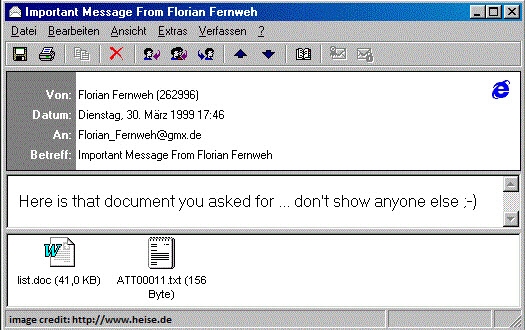
Office had been weaponized. This virus also did not harm the infected PCs, but was generating so much email that servers were getting gummed up in what is called a denial of service attack, or DoS. The system administrators in charge of mail servers were angry. More importantly, for the first time perhaps, hundreds of thousands or millions of white-collar workers were without email all at once, heading into a Monday morning of a workweek.
If there had been any doubt, we immediately learned how important email was to the workplace.
Our customers and offices around the world were angry.
News reports were everywhere (though reporters resorted to phone calls to report), and the number of mail servers impacted was in the tens of thousands, which was hundreds of thousands if not more PCs. This was huge.
What was going on? This was a new type of virus. It introduced the term “worm” to the general population, named such because it could automatically spread itself to other PC users without any action, worming its way around the internet. In the press the terms “worm” and “virus” were used interchangeably. Once released into the wild via a deliberately simple email, Melissa virus spread when a recipient opened the file attached to the “Important Messages.” The message was designed to look familiar and so the file was almost always opened.
That was social engineering.
The attachment contained a Word macro and was written in a way that not only bypassed any protections added to Word after WM/Concept.A but immediately disabled the macro protection features. In this sense, it was the same as the Concept virus. When using any mail program but Outlook, Melissa was like Concept both in how it spread and its annoyance level (high).
If a user was running Outlook, then Melissa went one step further. The code in the Melissa virus used the macro capabilities of Outlook—yes, Outlook had those too, and customers really loved them—to automatically send the same “Important Message” to the first 50 people in the Outlook address book. Instead of telling “two friends,” each infected PC was telling 50, and each of those who opened the attachment told 50 more. That’s how the virus spread across the whole planet in a weekend.
If there was any humor to it (there was not), after mailing 50 people the virus, the code checked if the current day of the month was the same as the minute. If by chance it was, it added the following text to the currently open Word: “Twenty-two points, plus triple-word-score, plus fifty points for using all my letters. Game’s over. I’m outta here.” This made no sense until there was a deep dive into where Windows kept program settings (called the registry), and where it recorded that Melissa infected the PC. There, text could be found reading “Kwyjibo.” Together those were a reference to an episode of The Simpsons, “Bart the Genius,” where Bart tries to cheat at Scrabble with that word.
Telltale metadata
Hunting down the propagators of viruses and worms was an internet hobby and a profession going as far back as Robert Morris and the infamous worm unleashed from Cornell in 1988 (while I was there for my first homecoming!) and sleuthed and then documented by Clifford Stoll in the incredible book The Cuckoo’s Egg: Tracking a Spy Through the Maze of Computer Espionage. Immediately, the internet tried to find clues to the origin of Melissa. In some ways this was similar to the Centers for Disease Control and Prevention trying to find patient zero. With email, this was possible because of the accurate time stamps and journey information in every message—the digital DNA of a computer virus.
Melissa offered up one other clue, unbeknownst to its creator. The LIST.DOC file had a GUID, the kind John Markoff wrote about (the same feature that we had just removed from Office). The tipster assisting Markoff, who we then knew to be Richard Smith, the CEO of software company Phar Lap, found the GUID and posted it online with the virus code. A graduate student in Sweden said the code looked familiar and pointed Smith to a user named VicodenES. Smith then began to connect the network card address (the same one he complained about as part of a GUID) and records of internet servers. Eventually, Smith was able to connect the whole trail of network card addresses to the creator of the virus, who was arrested in New Jersey at his parents’ home a week after releasing it.
The metadata in Office 2000 made that possible.
I wish I made that up.
We assisted IT managers and sysadmins in getting their systems back online and removing the virus. This was a criminal investigation, and for the Office team it was the first time we were involved in one at this scale and in real time. The week was filled with remorse, grief, anger, and finally, when we heard that metadata was involved in finding the criminal, pure disbelief.
The design approaches that worked for tech enthusiasts no longer worked for typical office workers.
As soon as we implemented these and put out updates, we heard from enterprise customers and the community of consultants, authors, and the Microsoft Most Valued Professionals, or MVPs (the group selected by Microsoft’s support professionals to represent the broad external community). We “broke” their solutions built on top of Outlook. Whether these were time management, scheduling assistants, customer relationship management tools for salespeople, or email automation (to name a few), the user was prompted by Outlook every time macros ran. It was annoying, but it needed to be that way because we did not have another readily available solution.
When people using software are in a flow going through some task (from opening email, to booking tickets, to opening a program, to browsing web pages) any warning messages are essentially ignored, and therefore meaningless.
This lesson was learned repeatedly by every generation of software. A warning message simply got in the way. No one reads text when there is an OK button right there.
As with Word, there was a gradual chipping away of the extensibility of Office. Our products (and customers) were put at risk due to an increasingly connected world. The design approaches we took that worked fine for tech enthusiasts no longer worked for typical office workers with relatively limited knowledge of the inner workings of PCs, and especially not for the administrators who supported them.
Once a virus is thwarted by any means, the community of bad actors works to find similar patterns to exploit, but ones that work around the fixes. In the meantime, an even larger community of copycats duplicate the existing exploit and take advantage of unpatched software or software protected by relatively unsophisticated antivirus tools that did not pick up on small changes to the pattern used. That’s how viruses work.
We briefly secured the product.
Microsoft’s Tylenol moment
The early May morning when I received that frantic call was my first notice of the outbreak of the new ILOVEYOU virus, and very quickly online news stories were reporting billions of dollars in damage, citing the previous Melissa exploit and the much earlier Concept virus in Word.
In reporting, once there are three points of evidence then there is a trend. In this case, the trend was the escalating risk of using Office and the escalating costs to business IT professionals maintaining corporate desktops—TCO, our old friend total cost of ownership, was again a critical issue.
In an online story posted the first evening of the spread, “industry experts” anticipated that by morning half of all PCs in North America became infected and more than 100,000 mail servers in Europe were infected or taken offline as a precaution. The United States Senate was infected, as were important news outlets such as Dow Jones. The infections reached worldwide telecom and television outlets in Denmark and employees of Compaq Computer as far away as Malaysia.
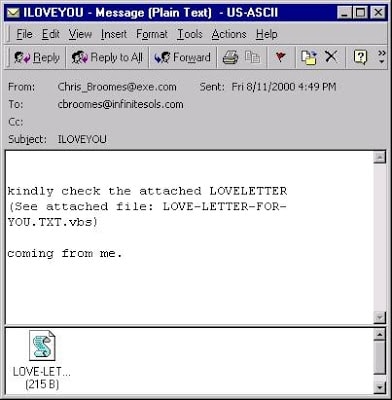
The impact was profound. Billions of dollars in immediate lost productivity and money spent to eradicate the virus. Customers were livid. If and how we responded to this was clearly going to be a test of the empathy for the pain customers were experiencing.
ILOVEYOU disabled mail servers and networked PCs around the globe, including many important government agencies from the U.S. Department of Defense to the UK National Health Service. WIthin a week of the attack, the U.S. House of Representatives Science Committee was holding hearings trying to get to the bottom of the virus problem, called “Love Bug” in the press, and why the industry failed to address it.
The creators of the ILOVEYOU worm exploited a hole in the warning messages that ran when Outlook’s data (such as contacts) was accessed. As with Melissa, the worm used the contact list and replicated itself, but instead of just the first 50 contacts it automatically (and silently) sent mail to all the contacts in an address book. This infection also installed itself on the computer so it continued to run all the time and did damage by deleting files and replacing them with copies of the virus. The infection was started by an email attachment with the name “Love Letter,” which was a hidden program and not a letter at all. Any email program would have been vulnerable to this method of transmission, which simply required the user to open the file on their PC, but Outlook was not only the most prominent, it was also the most easily programmable.
It was bad. Really bad.
The team was trying to figure out what to do and began exploring options.
Microsoft Office was having a Tylenol moment. While the human suffering of the computer virus was dramatically less than that of the 1982 product tampering that left seven people dead from poisoning, the brand suffering was comparable. Could Outlook be trusted? Could Microsoft? Tylenol’s parent company, Johnson & Johnson, took unprecedented and drastic measures to save lives and rebuild consumer confidence in the brand. It removed all medicine from distribution and encouraged the destruction of all pills. In addition, the company diagnosed and improved its systems, including the development of tamper-resistant packaging. In doing so, they developed the modern playbook for crisis management.
No matter how much or how little we broke, customers would complain.
Rob Price (RobPr), Outlook’s program-management leader, and WillK led the discussion. Their view was clear. First, we would disable sending a bunch of file types of attachments that people routinely sent or opened if they showed up in an inbox. Essentially, this meant not sending executable code or files that ran when opened. Second, we would guard Outlook so that any programmatic access to the address book or attempt to send email silently generated a warning and disabled access. Finally, although it seemed wonky, we would treat all email as untrusted, which basically meant that no matter how code was snuck into email, it did not run without a lot of warnings. We would effectively quarantine email messages and isolate the user’s important Outlook data from any code.
These acts could be enforced and customized by administrators in large companies.
The team wanted to talk about exactly how much “stuff” would break in the process. Outlook general manager Kurt DelBene (KurtD) and test manager Martin Staley (MartinSt) said that no matter how much or how little we broke, customers would complain we broke either too much or too little. Some things were super simple. For example, large companies compressed their files before emailing them as attachments, to save storage and bandwidth. A common way to send them without requiring a separate program to decompress them was to have the compressed file sent as an executable file, which was automatically decompressed and saved on the local hard drive when opened as an attachment. This extension to Outlook was popular. And it would be totally broken, rendering attachments invisible to recipients.
The debate was not whether to make these changes as soon as possible, but whether we should even enable companies to turn them off or somehow reduce the scope of protection. As veterans of the past few rounds of viruses, we were reluctant to enable IT Pros to reduce the protections on a PC. Their assessments weighed the risk of an important boss or stakeholder not getting work done with the support costs across an organization if a virus were to surface. We knew with any option that some percentage of customers would side with more pain in after-the-fact remediation than the pain of prevention. It was the wrong tradeoff, but the kind that is often made in IT organizations when they are put on the defensive because of weaknesses of the products they are supporting.
What the team really wanted was permission to cause the pain. They knew what needed to be done but knew there would be pushback. They wanted to know I would support them. For that, I did not hesitate given how much pain we had already caused and how much they clearly understood about the problem and solution. There was so much going on to suggest this significantly undermined the whole value proposition of Office that I wondered if we would have to introduce Outlook-free versions of Office (and reduced pricing—everything always came back to pricing).
In four weeks, on June 8, 2000, the team completed the patch and made it available for download—the infamous Outlook Email Security Update. It went out for Outlook 97, Outlook 98, and Outlook 2000 and for all sub-versions of those products all around the world.
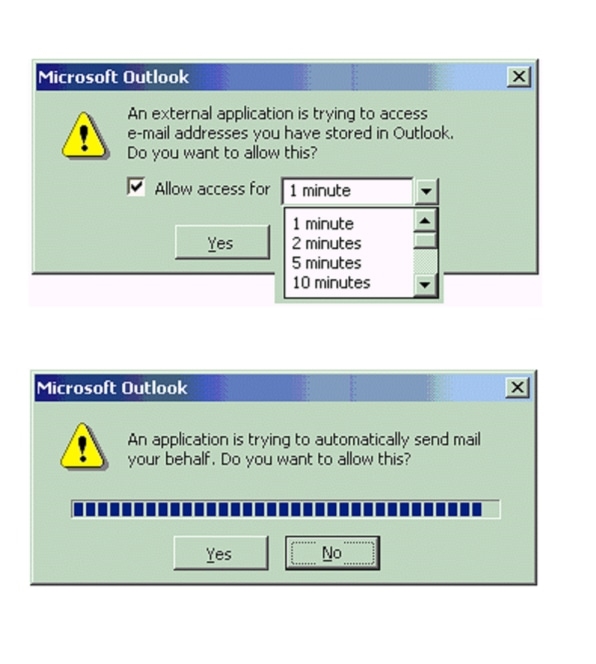
Four weeks might seem like a long time, but cleansing PCs of the problem was time-consuming and occupied IT. The antivirus vendors and email security products did their part. We notified PSS and field sales. Marketing prepared a library of materials, as did Support, who wrote detailed technical articles for the Microsoft Knowledge Base. We issued a long “interview” with me, as a news release, detailing all the fixes. We did calls with the major press outlets.
The rollout was bumpy. With every virus, the knowledgeable PC enthusiasts tend to take a blame-the-users stance when faced with an update that diminishes PC capabilities. We saw this with both Concept and Melissa. In the case of LOVE, features like mailing around code were precisely what enthusiasts did frequently, so they were rather irate. In forums they complained, “Who opens attachments from people you don’t know?” People are busy and expect PCs to work. They don’t view using a PC in the same vein as walking down a dark alley in a strange city. Quickly, the community took to trying to find workarounds for the security changes, but to no avail. Several declared that end users should change a few IT settings we did provide to return to “normal.”
Enterprise admins behaved as expected. Some optimized for the near term. Others took the pain in changing workflow and incompatibilities. Outlook, with the email security update, was the new normal and eventually accepted. It was still foolish to have made light of these changes. While in hindsight it all seemed easy, the idea of breaking an important ecosystem, for a new product especially, was antithetical to Microsoft’s focus on compatibility. What the team proposed and then delivered was gutsy.
Office continued to have fewer and mostly less severe viruses for decades to come. At least a part of that was due to the Outlook Email Security Update.
Tech enthusiasts, IT pros, and even our beloved MVPs complained for years and wrote many articles pejoratively referring to the Email Security Update as they adjusted to a new normal for Outlook.
The world moved on. And it was a bit safer using Office and Outlook
(110)